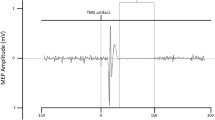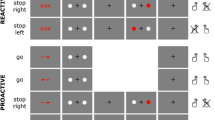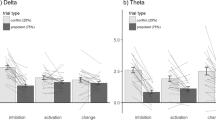Abstract
Reaction time (RT) is shortened when the response signal is preceded by a warning signal, a finding that has been attributed to response preparation during the foreperiod between the warning and response signals. Research suggests an increased excitability of cortical movement representations associated with response preparation during the foreperiod of a warned RT task (Davranche et al. in Eur J Neurosci 25:3766–3774, 2007). However when the foreperiod duration is short and constant, the motor evoked potential (MEP) amplitude elicited by transcranial magnetic stimulation (TMS) during the foreperiod is suppressed (Touge et al. in Clin Neurophysiol 111:1216–1226, 1998), suggesting a competing inhibitory process. Three experiments measured MEP amplitude and intracortical inhibition during the foreperiod of a warned RT task in which the response was a flexion of the right index finger. Experiments 1 and 2 measured short-interval intracortical inhibition (SICI) with paired TMS pulses separated by inter-stimulus intervals (ISIs) of 3 (SICI3) and 1.5 ms (SICI1.5), respectively. Experiment 3 measured long-interval intracortical inhibition (LICI) with paired TMS pulses with an ISI of 100 ms (LICI100). In all experiments MEP amplitude was smaller in the warned condition than in the unwarned condition. There was less SICI3 in the warned condition than in the unwarned condition (Experiment 1) whereas SICI1.5 was similar in both conditions (Experiment 2). There was less LICI100 in the warned condition than in the unwarned condition (Experiment 3). The intracortical inhibitory processes measured here cannot explain the suppression of MEP amplitude in the warned condition. We propose that the suppression of MEP amplitude is the result of an inhibitory mechanism, which acts on primary motor cortex to prevent premature response during the foreperiod.



Similar content being viewed by others
References
Bastian A, Schoner G, Riehle A (2003) Preshaping and continuous evolution of motor cortical representations during movement preparation. Eur J Neurosci 18:2047–2058
Begum T, Mima T, Oga T, Hara H, Satow T, Ikeda A, Nagamine T, Fukuyama H, Shibasaki H (2005) Cortical mechanisms of unilateral voluntary motor inhibition in humans. Neurosci Res 53:428–435
Bertelson P (1967) The time course of preparation. Q J Exp Psychol 19:272–279
Bertelson P, Tisseyre F (1968) The time-course of preparation with regular and irregular foreperiods. Q J Exp Psychol 20:297–300
Burle B, Bonnet M, Vidal F, Possamai CA, Hasbroucq T (2002) A transcranial magnetic stimulation study of information processing in the motor cortex: Relationship between the silent period and the reaction time delay. Psychophysiology 39:207–217
Churchland MM, Santhanam G, Shenoy KV (2006) Preparatory activity in premotor and motor cortex reflects the speed of the upcoming reach. J Neurophysiol 96:3130–3146
Davranche K, Tandonnet C, Burle B, Meynier C, Vidal F, Hasbroucq T (2007) The dual nature of time preparation: neural activation and suppression revealed by transcranial magnetic stimulation of the motor cortex. Eur J Neurosci 25:3766–3774
Dum RP, Strick PL (2002) Motor areas in the frontal lobe of the primate. Physiol Behav 77:677–682
Fecteau JH, Munoz DP (2006) Warning signals influence motor processing. J Neurophysiol 97:1600–1609
Fisher RJ, Nakamura Y, Bestmann S, Rothwell JC, Bostock H (2002) Two phases of intracortical inhibition revealed by transcranial magnetic threshold tracking. Exp Brain Res 143:240–248
Hasbroucq T, Kaneko H, Akamatsu N, Possamaï CA (1999) The time-course of preparatory spinal and cortico-spinal inhibition: an H-reflex and transcranial magnetic stimulation study in man. Exp Brain Res 124:33–41
Koch G, Franca M, Del Olmo MF, Cheeran B, Milton R, Sauco MA, Rothwell JC (2006) Time course of functional connectivity between dorsal premotor and contralateral motor cortex during movement selection. J Neurosci 26:7452–7459
Kujirai K, Kujirai T, Sinkjaer T, Rothwell JC (2006) Associative plasticity in human motor cortex during voluntary muscle contraction. J Neurophysiol 96:1337–1346
Kujirai T, Caramia MD, Rothwell JC, Day BL, Thompson PD, Ferbert A, Wroe S, Asselman P, Marsden CD (1993) Corticocortical inhibition in human motor cortex. J Physiol (Lond) 471:501–519
Lépine D, Glencross D, Requin J (1989) Some experimental evidence for and against a parametric conception of movement programming. J Exp Psychol Hum Percept Perform 15:347–362
Mars R, Bestmann S, Rothwell J, Haggard P (2007) Effects of motor preparation and spatial attention on corticospinal excitability in a delayed-response paradigm. Exp Brain Res 182:125–129
Näätänen R (1971) Non-aging fore-periods and simple reaction time. Acta Psychol (Amst) 35:316–327
Nickerson RS (1973) Intersensory facilitation of reaction time: energy summation or preparation enhancement. Psychol Rev 80:489–509
Requin J, Brener J, Ring C (1991) Preparation for action. In: Jennings JR, Coles M (eds) Handbook of cognitive psychophysiology: central and autonomic nervous system approaches. John Wiley, New York, pp 357–448
Reynolds C, Ashby P (1999) Inhibition in the human motor cortex is reduced just before a voluntary contraction. Neurology 53:730–735
Romaiguére P, Possamai CA, Hasbroucq T (1997) Motor cortex involvement during choice reaction time: a transcranial magnetic stimulation study in man. Brain Res. 755:181–192
Roshan L, Paradiso GO, Chen R (2003) Two phases of short-interval intracortical inhibition. Exp Brain Res 151:330–337
Sanger T, Garg R, Chen R (2001) Interactions between two different inhibitory systems in the human motor cortex. J Physiol (Lond) 530:307–317
Sawaguchi T, Yamane I, Kubota K (1996) Application of the GABA antagonist bicuculline to the premotor cortex reduces the ability to withhold reaching movements by well-trained monkeys in visually guided reaching task. J Neurophysiol 75:2150–2156
Shimazu HH, Maier MMA, Cerri GG, Kirkwood PPA, Lemon RRN (2004) Macaque ventral premotor cortex exerts powerful facilitation of motor cortex outputs to upper limb motoneurons. J Neurosci 24:1200–1211
Stinear CM, Walker KS, Byblow WD (2001) Symmetric facilitation between motor cortices during contraction of ipsilateral hand muscles. Exp Brain Res 139:101–105
Takei T, Hashimoto T, Hagura N, Matsumura M, Naito E (2005) Reduction of cortico-spinal excitability by transcranial magnetic stimulation at predictable timing. Jpn J Physiol 55:93–99
Tanji J, Evarts E (1976) Anticipatory activity of motor cortex neurons in relation to direction of an intended movement. J Neurophysiol 39:1062–1068
Touge T, Taylor JL, Rothwell JC (1998) Reduced excitability of the cortico-spinal system during the warning period of a reaction time task. Electroencephalogr Clin Neurophysiol 109:489–495
Trillenberg P, Verleger R, Wascher E, Wauschkuhn B, Wessel K (2000) CNV and temporal uncertainty with ‘ageing’ and ‘non-ageing’ S1-S2 intervals. Clin Neurophysiol 111:1216–1226
Valls-Solé J, Pascual-Leone A, Wassermann EM, Hallett M (1992) Human motor evoked responses to paired transcranial magnetic stimuli. Electroencephalogr Clin Neurophysiol 85:355–364
van den Hurk P, Mars RB, van Elswijk G, Hegeman J, Pasman JW, Bloem BR, Toni I (2007) Online maintenance of sensory and motor representations: effects on corticospinal excitability. J Neurophysiol 97:1642–1648
van Elswijk G, Kleine BU, Overeem S, Stegeman DF (2007) Expectancy induces dynamic modulation of corticospinal excitability. J Cogn Neurosci 19:121–131
Author information
Authors and Affiliations
Corresponding author
Rights and permissions
About this article
Cite this article
Sinclair, C., Hammond, G.R. Reduced intracortical inhibition during the foreperiod of a warned reaction time task. Exp Brain Res 186, 385–392 (2008). https://doi.org/10.1007/s00221-007-1241-4
Received:
Accepted:
Published:
Issue Date:
DOI: https://doi.org/10.1007/s00221-007-1241-4




